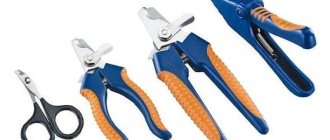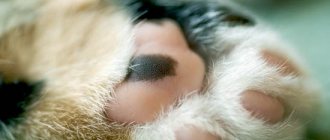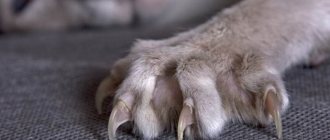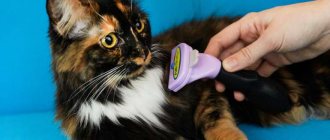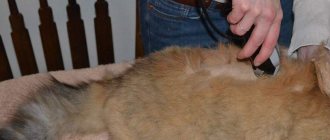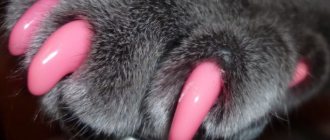Save the article:
If a person decides to have an animal in the house, then first of all it is important to find out what kind of care the animal requires. Cats calmly react to manipulations with a comb, many even like to bathe, but when the owner decides to trim the cat’s claws, that’s when problems begin. Even tiny kittens can become seriously angry if the procedure causes them the slightest disturbance. It is necessary to understand the animal’s fears of a procedure that is unnatural for its natural instincts. But there are objective reasons explaining why it is needed and what benefits it will bring to your pet.
It would be a mistake to approach the animal with a brave, quick step and immediately rush into battle - but a real battle will unfold for the right to wear long claws if you approach the matter at a swoop and without properly preparing the cat.
It’s good that you don’t need to discover America in this matter, and there are already ready-made working tips and detailed instructions to help you trim your cat’s claws correctly .
Why do you need to trim your nails?
global $ads_google; //data-ad-slot=”2475549904″ $ads_google = empty($ads_google) ? false : true; ?> if ($ads_google == false) {?>
$ads_google = true; ?> } ?>
Claws are horny skin formations that grow throughout life. Under natural conditions, claws are regularly worn down during life. An animal does not need to worry about shortening its nails, as a person does: nature itself does manicures for cats. Those animals that their owners release to frolic in the wild wear off their claws by climbing trees and running on asphalt.
Domestic cats also try to shorten their claws on the owner's walls, scratch the door frame and any wooden covering. How many times can you hear the indignation of owners about torn walls, upholstered furniture and numerous traces of cat scratches!
A scratching post allows cats to act in accordance with their instincts, but this does not help much - it’s trite, the cat can ignore the convenient device and enthusiastically continue to tear apart the corner of his favorite sofa. However, the scratching post will not have a significant effect on shortening the cat’s claws.
If you do not help the animal and do not trim the cat's claws, then long claws may grow into the pads of the paws, and the animal will suffer while walking.
Covers for claws
To protect furniture and people from cat claws, soft caps made of silicone or vinyl (“anti-scratch caps”) are used. They are glued to the claw with special glue.
But such cases are also not safe. The secretion of secretion from the glands of the fingertips does not stop. It begins to accumulate under the “anti-scratch”, which can lead to inflammation.
Also, cats often tear off the covers with their teeth and eat them. It is better to use such overlays for a short time. For example, until the baby grows up and understands that you cannot pull the cat’s fur and tail.
So, as you can see, the best solution for caring for the claws of cats and cats is a scratching post. It is necessary to teach a kitten from infancy not to scratch furniture and people, and then extreme measures will not be required.
Cat Nail Trimming Tools
Before telling you what tools are used to trim a cat’s claws, it is worth warning that they are not used under any circumstances: ordinary scissors are not suitable, however, neither is the housewife’s favorite manicure set. As an exception, sometimes only a nail file is used for polishing nails.
Specialized pet stores are not uncommon, as are veterinary pharmacies, so you can safely purchase a variety of cat care supplies there. In such places they will always advise and select convenient tools and even give advice on how to trim a cat’s claws.
What is used for cat manicure:
- a nail clipper, which must be sharp. Dull blades often hit sensitive areas and cause pain. Nail clippers are divided into sickle and guillotine clippers;
- a blood stopper or antiseptic. These medications may come in handy if you hit a sensitive part. Iodine or hydrogen peroxide work great. After cauterization, the wound is sprinkled with baby talcum powder;
- blisters - special scissors that look like manicure scissors, but are designed to resemble a cat’s claw;
- file for polishing;
- Long-haired cat breeds, such as Persians, will need a hair clipper, as fur on the paws interferes with the claw trimming process. If the cat is shy or the sound of the running machine irritates him, then the fur from the paws is cut off by hand using scissors;
- alcohol to disinfect accessories. All nail trimming tools must be sanitized before the procedure begins.
Sharp claws in cats: is it possible to fight?
Contents hide
Sharp claws in cats: is it possible to fight?
The fact that it is vital for a cat, like any predator, to keep its claws in “working” condition is known to all cat lovers. Everything that comes across is used: furniture, carpets, wallpaper, etc. Soon any apartment can take on a very dull appearance. Therefore, knowing about this behavioral feature, many deny themselves the pleasure of having a cat. What do authoritative experts think on this issue?
Alas, this behavior is the norm for our furry and tailed friends. Yes, they need to keep their claws sharp - along the way, cats also train the muscles of their paws, which in the future will allow them, if necessary, to use their extraordinary climbing abilities! Furniture and wallpaper are under threat, you say? And look at your hands and feet, and you will probably find deep grooves - “scratches” there. Well, indeed we are faced with a problem!
The Americans, with their characteristic pragmatism, tried to solve it radically, by surgically removing the claws on the front paws so that they would not grow back. In Europe, such operations were immediately abandoned, recognizing them as inhumane to animals. Looking at their colleagues from the Old World, the Americans also became ashamed, so in the USA such operations are now rare and are essentially considered barbaric.
And yet there are some ways to improve the situation, let's look at them in more detail.
Scratching posts. In principle, all cat owners know about this useful accessory, but the trouble is that they often remain standing where they were placed. Cats continue to sharpen their claws wherever they see fit!
Well, this is quite natural. It may happen that the scratching post you bought is simply not of interest to your pet - all cats have their own ideas about this. Spend some money, experiment with shapes and sizes - perhaps you will like some option.
In particular, a cheap and economical solution is a sisal rug. Many animals love to torment him! Try to seduce the cat, smear the chosen scratching post with valerian, offer or place some other treats around. Try to work according to the principle of training: the “projectile” is used for its intended purpose - get a reward!
Make goals less attractive. Surely your pet has several favorite things or objects in the apartment that he chooses as “victims”. Your task is to ensure that these objects and things lose their attractiveness to the cat. Secure (fix) carpets, cover furniture with a protective coating - these measures should help. But the protective coating can also have a dual function. Otherwise, this is called a “sacrificial covering” - something that a cat can scratch without restraint!
Scare the cat away. You may not know, but there are many completely safe products that smell to repel cats. Use them as natural repellers! So, cats do not like the rich aromas of citrus fruits and apples - they turn around and leave. Suitable sprays are available for sale! Just make sure this product is non-toxic to cats before use.
Try trimming your pet's nails. This method should be used if the animal, in a fit of emotion, loves to demonstrate its love and appreciation by scratching your hands or some other parts of the body. We agree – all of this can be quite painful. For these purposes, there are special “machines” - nail trimmers; you need to resort to their help about once every two to three weeks. At the same time, see if the incessant scratching is a consequence of any behavioral problem.
Try the caps! One of the recent achievements of cat fashion is rubberized or even plastic caps that are placed directly on the claws. Also one of the radical methods, and quite effective!
That is, now your cats can hone their natural instincts on anything and anyone - the rubber coating will reduce all negative consequences to zero. The threat to your skin is eliminated by itself. Well, if the cat chews through such a “covering” itself, there will be no harm to its body.
Please note that caps should only be used if the animal is kept exclusively indoors. Going outside, the cat will instantly become defenseless in the face of external dangers. There are also disadvantages to using caps - they deteriorate relatively quickly, require your constant attention, and in general are not very good for long-term use.
Choose the method that suits you best. If you can offer something of your own, share it in the comments!
Original publication: Some Safe, Cat-friendly Solutions To Clawing And Scratching. Source and photo:
How to prepare your cat for the procedure
The owner must know the character of his cat and be able to adapt any procedures to it. This is especially true for nervous or aggressive animals - they may react ambiguously. It’s good if more than one person trims a cat’s claws at home: in such a matter, an assistant will not be superfluous.
A cat that is quite nervous and struggles vigorously should not be forced. In the process of fighting, trimming the claws can injure the paws. You should wait until your cat is in a calm mood before attempting to trim her nails again.
global $ads_google; //data-ad-slot=”2475549904″ $ads_google = empty($ads_google) ? false : true; ?> if ($ads_google == false) {?>
$ads_google = true; ?> } ?>
They begin to accustom the animal to any manipulations at the age of a kitten. In any case, the pussy should not be afraid of having its paws touched. Prepare all the tools and wait until your pet is calm.
First, the cat is stroked on its paws and its favorite places. Be sure to stroke every paw. If your pet wants to leave, do not delay her - she must be sure that nothing will be done against her will, and she will calm down.
If your furry pet lets you pet its paws, you need to praise it and treat it with treats. She will get used to such manipulations and will be happy to allow you to touch her limbs.
The cat's paw is placed on the palm and treated with a special treat, which will be given whenever they plan to trim their claws. The paws are massaged one by one with the fingers and at the same time the claws are examined. An animal that trusts its owner will allow pressure on the pads to release its claws.
Basic rules for trimming nails
To trim a cat’s claws without any problems, you need to follow the same scenario, which includes preparing the animal and the procedure itself.
You can entrust a cat's manicure to a specialist, but it is quite possible to trim a cat's claws at home on your own.
- The claws contain a number of nerve endings and blood vessels that form the pulp. It should not be injured, as it immediately begins to bleed and the animal becomes very painful. No more than 2 mm of the stratum corneum is cut off.
- The procedure is scheduled for daytime so that the claws are clearly visible.
- After preparing the animal, they take it on their lap and talk affectionately. The cat hears the owner's voice and is distracted by it.
- Lightly press on the pad of the paw: the claws should appear.
- Using forceps, only the upper part of the stratum corneum is cut off.
- Repeat the same with the hind legs.
- It is better to sand the ends of the cuts with a file and be sure to remember to treat each area with an antiseptic.
- After the manicure, the cat is praised and again treated to treats.
To properly trim a cat’s claws , take into account the condition of the animal: do not touch the animal on an empty stomach or during active pastime. You must be confident in the health of your pet. But when the cat is getting ready for bed, has eaten a hearty meal and looks happy - it’s time.
If it so happens that the family favorite has damaged its claw, but its condition is not recommended for haircuts, leave it alone for a while. Manicure must be done strictly according to the rules!
How to properly trim a cat's claws
Before you begin the exciting procedure, you need to make sure that the cat is in a good mood. The state of mind of the owner is also important. He must exude positivity, goodwill and at the same time – inflexibility and self-confidence. Under no circumstances should you fuss.
- Place a light near your work area so that you can carefully examine the claw, determining where the pulp begins.
- Wash your hands with soap, treat them with an antiseptic, and disinfect your chosen nail trimming tool.
- Gently sit the cat on your lap (with its back facing you), take the paw that you will treat first in your hand, and hold it firmly. If the animal begins to actively object, swaddle it in a towel or dress it in overalls. You may need to call an assistant to help.
- Gently press the center of the pad with your fingers to extend the claw to its maximum length.
- Place a nail clipper (scissors) on the curved part of the claw, choosing the correct angle - along the line of its growth, that is, the trimmed claw should not differ in shape from the untrimmed one. The cutting direction is from bottom to top.
- Stepping back at least 2 mm from the edge of the pulp, cut off part of the claw in one motion.
- If there are any rough spots left on the claw, you can get rid of them using a nail file, a diamond-cut file, or a whetstone. Just keep in mind that friction usually causes extreme irritation and anxiety in the animal. In addition, there is a risk of delamination of the claw if its edges are processed with excessive force. The pressure should be light.
- Trim all the claws, then give the cat a treat, even if she has not shown submissiveness.
Don't forget that the fluffy has 18 toes with claws (5 on the front paws and 4 on the back paws). At the end of the procedure, it is advisable to make sure that you have processed each one. One forgotten sharp claw can create discomfort for an animal.
How often to trim a cat's claws
Cat manicures are done as needed, namely as soon as the length of the stratum corneum grows. Usually this takes three weeks. If you do this less often, the animal will wean itself off the procedure.
Always trim before exhibition.
It is enough to check the condition of her claws once a week, and an attentive owner will understand when it is time to trim the cat’s claws.
If something goes wrong, the animal may require veterinary attention. Remember that the main conditions for cutting are the cleanliness of the tools and the animal’s trust in you.
